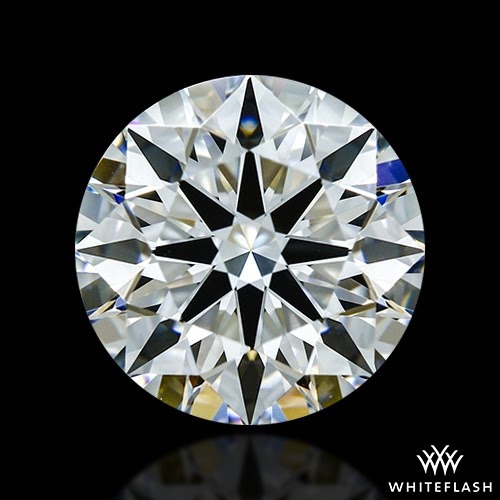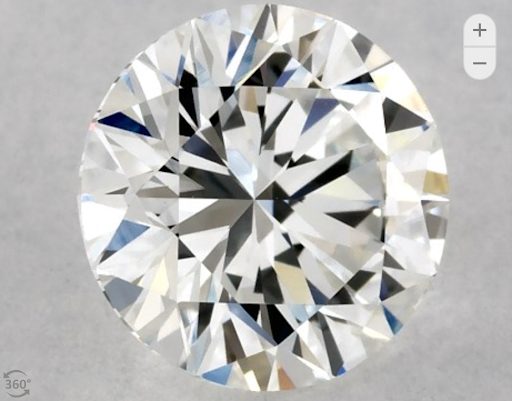This page contains references to diamonds or engagement rings from different companies. Sometimes I do receive a commission when you click on links and buy the products.
Some of you may have seen our guide to VVS1 clarity diamonds, where we delved into what made VVS1 so compelling. Well, VVS2’s are cut from the same cloth. Yes, they sit just below VVS1 diamonds on the clarity grade, but that doesn’t mean that they don’t offer the same awe-inspiring qualities that a VVS1 does.
Explore this guide to discover exactly what the term ‘VVS2’ means, what a diamond like this can provide for you, and much more.
- What Is a VVS1 Clarity Diamond?
- Why Choose a VVS1 Clarity Diamond?
- The Cost of a VVS1 Clarity Diamond
- Should you Buy a VVS1 Clarity Diamond?
- How to Choose a VVS1 Clarity Diamond
- VVS1 Clarity Diamonds: Our Recommendations
What Is a VVS2 Clarity Diamond?
The acronym ‘VVS’ itself actually stands for Very Very Slightly Included, which refers to inclusions—internal blemishes that are present in almost all diamonds. Now, most of these are invisible to the naked eye and can only be viewed through magnification. This is what VVS is all about, as it refers to the overall clarity of the diamond.
VVS2 is part of the VVS category, the counterpart of VVS1. You can see the scale below, with grading’s chosen and determined by the American Gem Society. The gradings themselves are given stringently, with diamonds undergoing multiple examinations, such as through angular spectrum evaluation and creating ideal-scope images that reveal the true characteristics of a specific diamond. This allows a diamond expert to effectively grade the diamond on things such as clarity, but also color, cut, and carat weight—which are referred to as the Four Cs.

VVS2 diamond themselves are able to provide an incredible amount of sparkle and brilliance, due to the fact that they have relatively few internal blemishes that will always be incredibly minute, even being imperceptible to the naked eye. Only through 10x magnification will blemishes such as these be able to be seen.
How Much do VVS2 Diamonds Cost?
The cost of a VVS2 clarity diamond ranges due to multiple factors such as the color and the quality of the cut. For example, a 1 carat VVS2 diamond with D-graded coloration and an Ideal cut will most likely cost more than a diamond of the same weight, but with F-graded coloration and a fair cut.
The relative qualities of a diamond greatly affect its price. For example, let’s compare these two diamonds from Blue Nile. Consider this first diamond, a 1.00-Carat Round Cut Diamond. It’s VVS2 clarity, with a cut ranked as ‘good’, and costs $6,261.
To see the difference a certain characteristic makes, look at this 1.00-Carat Round Cut Diamond—it’s the same carat weight, the same color, the same clarity grade, but costs $7,998. The key difference here is the quality of the cut. While the size, color, and clarity are the same, this latter diamond is an Ideal cut, which is superior to a good cut. So think about what you want to get out of a diamond and what you’re prepared to pay.
Please note that prices are subject to change.
Should You Buy A VVS2 Clarity Diamond?
First things first, whenever you buy a diamond, make sure it’s eye-clean. The great thing about VVS2 is that they’re always naturally eye-clean.
Many people buy VVS2 diamonds because they are less expensive than flawless diamonds and cost considerably less. This makes them a cost-effective investment that will continue to dazzle over the years.
How to Choose a VVS2 Clarity Diamond
We’ve spoken about clarity and cut—but what do they actually refer to and how should they influence what you buy?
Choosing a diamond is usually dictated by the Four Cs; Carat, Cut, Clarity, and Color. Now, as we’re talking VVS2 Clarity Diamonds, that C has already been decided. However, remember to weigh up the others:
Cut
When it comes to diamonds, cut is the most important factor for determining quality, as it actually has the most impact on the overall quality and the light performance of the diamond.
When cut, a diamond is essentially an item containing a number of tiny mirrors, each taking in and bouncing light in multiple directions. For the best light performance, a diamond should be cut with absolute precision, which makes for better light performance. The American Gem Society provides a grading scale for diamond cuts:
- 0 – Ideal
- 1 – Excellent
- 2 – Very Good
- 3, 4 – Good
- 5, 6, 7 – Fair
- 8, 9, 10 – Poor
You can find more information about diamond cut on our diamond cut education page.
Color
While, in general, the standard for an excellent diamond is colorless, color is really a subjective feature of a diamond. Many retailers and buyers want colorless, while others can be particularly interested in colored diamonds.
For example, if a diamond is colored with a very saturated yellow color, it’s known as either a ‘fancy yellow diamond’ or a ‘canary diamond’, which is quite popular in some circles.
If you’re looking for a colorless VVS2 Clarity Diamond, choose a diamond that sits within the colorless ‘D-F’ bracket.
Carat
For the uninitiated, carat represents the weight of the diamond. Usually, the higher the carat, the more expensive the diamond, as higher carat diamonds are rarer than their smaller counterparts.
One carat diamonds set the industry standard, being the most popular weight. With many retailers, you can search for diamonds through weight alone, with many offering their weighings within three decimal points.
However, like color, diamond carat is subjective.
What’s the Difference Between VVS1 and VVS2 Clarity Diamonds?
The difference between VVS1 and VVS2 is based on inclusions. However, the naked eye won’t be able to tell the difference. Only with magnification can diamond experts determine whether a diamond is VVS1 or VVS2.
A trained gemologist will be looking for both the number and size of any inclusions present. If a diamond has inclusions visible from the face-up view, the top half of the diamond, or table down, it will be classified as VVS2.
However, all of these inclusions will be microscopic, and you’d never be able to tell that your diamond might have an internal blemish or two.
Examples of Stunning VVS1 Diamonds
One of our favorite ranges of quality diamonds is from Whiteflash. Their A CUT ABOVE® range provides some of the very best diamonds available on the market today.
0.824 ct D VVS2 A CUT ABOVE® Hearts and Arrows Diamond
This diamond has been classified VVS2 by the AGS, with the colorless ‘D’ rank that diamond purists always aim for. This diamond is also Ideal cut, meaning it is one of the finest-crafted examples of a diamond available on the market today.
This is a slightly larger diamond compared to the latter, with a slightly lower color grade, but don’t let that turn you away, as E is still one of the highest-ranked color grades. It’s also an AGS-certified Ideal cut, meaning its light performance will be incredible. Plus, considering this is a larger diamond, it’s the ultimate choice for a diamond engagement ring.
Here’s a fantastic example from James Allen, a 1 Carat E VVS2 Excellent Cut Diamond:
This 1 carat round diamond E color vvs2 clarity has Excellent proportions and a diamond grading report from GIA.
VVS2 Clarity Diamonds: What We Recommend
Overall, it’s well worth purchasing a VVS2 diamond. Not only do they shine just as brightly as a Flawless diamond, but they are also more accessible in terms of both price and rarity. But make sure that you’re choosing an eye-clean diamond from a reputable diamond retailer.
Whiteflash has more of a focus on cut, however James Allen and Blue Nile have a fantastic variety and a better selection of fancy shapes.

Richard Jenkins, The Diamond Guru
Get free assistance from the Diamond Guru today. You’ll be glad you did!
- Secure the best quality diamond for your budget.
- Don’t pay over the odds for your diamond ring.
- Have peace of mind that you didn’t get ripped off.
Have a Question? Contact us now…



